Resistance bands are large rubber bands that you can push and pull to mimic free-weight exercises.
Their popularity has skyrocketed in recent years, primarily because they’re cheap, and you can do effective resistance band workouts wherever you are (in a confined space in your house or a cramped hotel room, for example).
This has led many people to question whether training with barbells, dumbbells, and machines is even necessary or if a few rubber bands are all we need to build muscle, gain strength, and stay healthy.
In truth, claiming a resistance band workout routine can replace a traditional strength training program is a stretch (har har), but resistance band workouts can be effective for certain people some of the time.
In this article, you’ll learn what resistance bands are, their benefits and downside, the best resistance band exercises, the best resistance band workout plans for beginner, intermediate, and advanced weightlifters, and more.
Table of Contents
+
What Are Resistance Bands?
Resistance bands, also known as “workout bands” or “exercise bands,” are elastic bands or tubes that are used as an alternative to barbells, dumbbells, and machines in resistance training.
They come in a range of lengths, colors, designs (some have clips so you can attach handles, for example), and “resistance levels.” The “heavier” the band, the more force you must apply to stretch it.
In other words, using heavy bands is comparable to lifting heavy weights, and using light bands is comparable to lifting light weights.
Resistance band exercises typically involve wrapping a band around a part of your body or a fixed object, then stretching the band using movements that mimic barbell, dumbbell, or machine exercises.
Benefits of Resistance Bands
1. They can help you build muscle.
Some “experts” say that resistance bands are as effective as free weights for building muscle and gaining strength because several studies show that training with resistance bands activates your muscles as well as training with free weights.
This isn’t exactly true, though, because high levels of muscle activation don’t necessarily lead to more muscle growth and strength gain.
That said, some studies show that resistance bands can be effective for building muscle and gaining strength under certain circumstances—particularly if you’re older, new to strength training, or recovering from an injury.
2. They’re ideal for working out at home and traveling.
Many people like to work out at home or in a hotel gym or room while traveling.
Not everyone has the space or budget for a fully stocked home gym, though, and most hotel gyms are poorly equipped.
In both cases, resistance bands can be an effective stopgap.
Resistance bands cost significantly less than traditional gym equipment, are easy to transport, and you can use them to do an effective workout even when you have limited space.
3. They’re ideal for beginners.
Stepping into a gym to do heavy barbell training when you’re an absolute beginner can be an intimidating prospect.
At-home resistance band workouts are a great way to build a base level of strength and learn proper technique on foundational exercises like the squat, bench press, and deadlift, which eases the transition to barbell-based strength training.
Downsides of Resistance Bands
1. They’re not optimal for building muscle.
Research shows that training a muscle through a full range of motion generally results in more muscle growth than training a muscle through a partial range of motion. One of the reasons for this is that when you move through the entire available range of motion on an exercise, your muscles are under load when they’re most stretched.
While scientists aren’t entirely sure why this is, their current best guess is that placing your muscles under load when they’re stretched better activates a protein called focal adhesion kinase, which directly stimulates protein synthesis.
What does this have to do with resistance bands?
Due to the nature of resistance-band exercises, the band provides the least resistance when your muscles are at their most stretched during an exercise, which robs these exercises of some of their benefits.
Take the banded push-up, for example. The band offers the most resistance when you’re at the top of the push-up with your elbows locked out and your pecs are at their shortest (most contracted). When your pecs are in their most stretched position at the bottom of the push-up, the band offers little-to-no resistance.
It’s a different story with free weight exercises, though. In the bench press, for instance, your chest muscles have to work hard against the load throughout the full range of motion, including when they’re most stretched (when the bar is touching your chest).
Thus, while resistance band workouts are typically better than body-weight workouts, they aren’t as effective as barbell or dumbbell workouts for building muscle.
This is why barbell and dumbbell exercises form the basis of my workout programs for men and women, Bigger Leaner Stronger and Thinner Leaner Stronger,
2. It’s difficult to use progressive overload with resistance bands.
The best way to ensure you keep getting bigger and stronger is to force your muscles to produce greater and greater levels of tension in your workouts. This is known as progressive overload, and the easiest way to achieve it is by gradually lifting heavier weights over time.
When you use a barbell, this is a straightforward process: you add weight to the bar every time you’re strong enough to do so.
Things aren’t quite so simple when you use resistance bands. Resistance bands have different tension levels (which you can think of as different weights), but the jumps between each are larger than the jumps you’d make with conventional weightlifting.
For example, every time the weight you’re using for a barbell exercise begins to feel too easy, you might add five pounds to each side of the bar (10 pounds total) so that the exercise feels challenging again. You can use a similar strategy when you train with resistance bands, only the increments are likely to be larger—15-to-25 pounds in most cases.
The problem with this is that it forces you to add weight faster than you should, which often causes weightlifting plateaus and increases your risk of injury.
3. They’re more awkward to use than free weights.
Generally speaking, band exercises are more awkward to set up and do than free-weight exercises, especially when it comes to performing tried and true muscle-building exercises such as squats, deadlifts, and lunges.
What’s more, resistance bands have a tendency to shift out of place while working out, which makes it difficult to track your progress during workouts and from week to week.
For instance, when you wrap a band around your back to do a set of banded push-ups, you may unknowingly have the band twisted, looped too low around your mid-back, or too high around your shoulders or neck.
This will change the way the exercise feels set-to-set and may alter the amount of resistance your muscles work against, which makes accurately tracking your workouts nigh-on impossible.
When you train with barbells, dumbbells, and machines, exercises are more stable and balanced and every set feels virtually identical, which helps to make training more comfortable and progress more consistent.
The Best Resistance Band Exercises
Before we get into the best resistance band workouts, we first need to cover the best resistance band exercises for your chest, back, shoulders, legs, and arms.
Resistance Band Chest Exercises
1. Banded Push-up
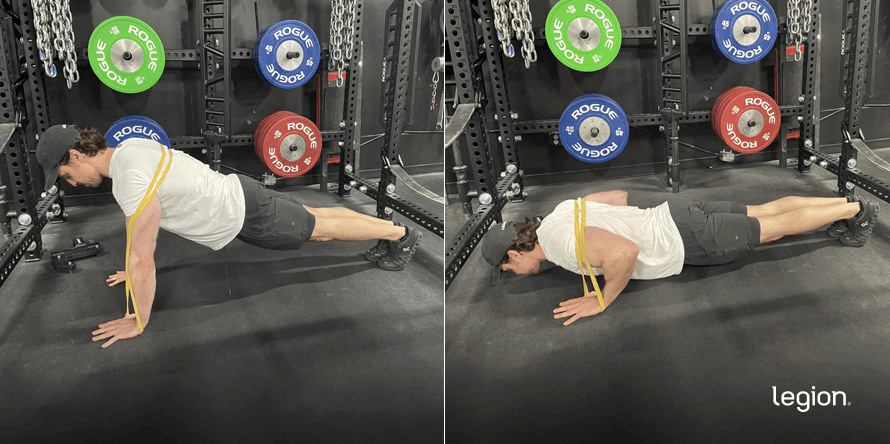
While holding one end of an exercise band in each hand, wrap the band around your back. Get on all fours and place your hands slightly wider than shoulder-width apart. With your arms outstretched, the band should pass just under your armpits, or over the top of your triceps.
Extend your legs behind you, so that your weight is supported on your hands and toes, and your body forms a straight line from your head to your feet. Keeping your back straight, lower your chest to the floor, and then push your body up and return to the starting position.
2. Banded Feet-Elevated Push-up
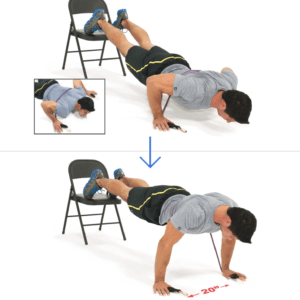
While holding one end of an exercise band in each hand, wrap the band around your back. Place your hands slightly wider than shoulder-width apart and rest your toes on a bench, chair, or other surface that’s about knee-height off the floor. With your arms outstretched, the band should pass just under your armpits, or over the top of your triceps. Straighten your back so that your body forms a straight line from your head to your feet.
Keeping your back straight, lower your chest to the floor, and then push your body up and return to the starting position.
3. Banded Chest Press
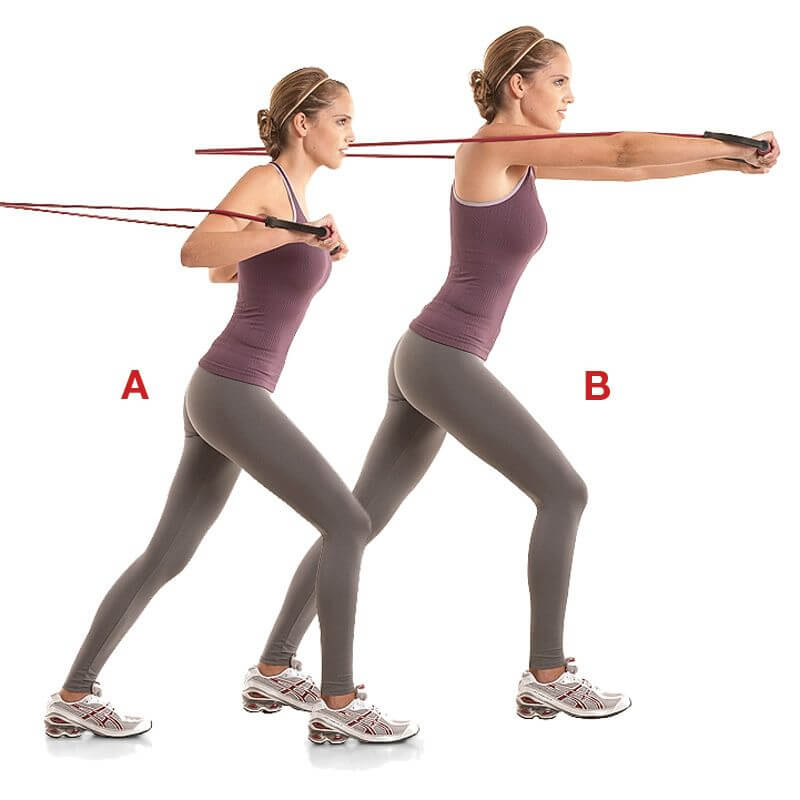
Wrap an exercise band around a sturdy post, piece of furniture, or tree at about the height of your midchest. Turn your back to the post, grab hold of one end of the band in each hand, lift your hands to nipple height so that your elbows are slightly behind you and the band passes over the top of your triceps, and place your feet shoulder-width apart
Press the ends of the band straight out in front of your chest, then reverse the movement and return to the starting position.
Resistance Band Back Exercises
1. Banded Deadlift
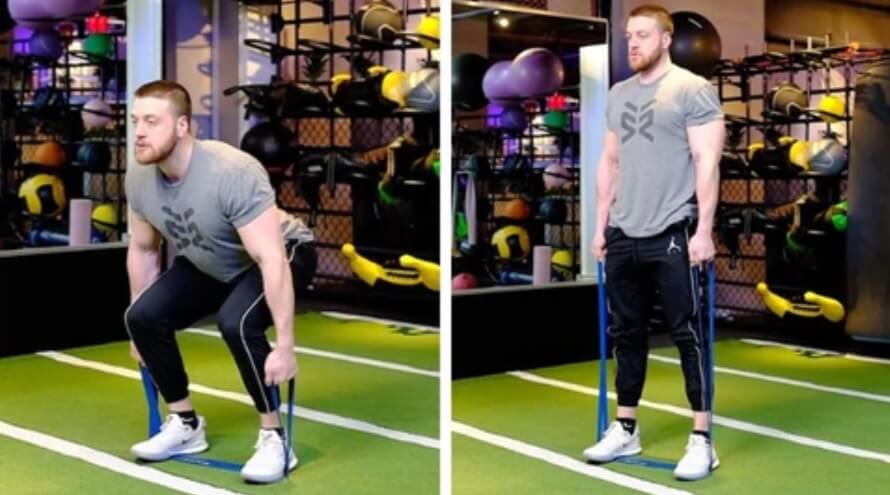
Stand on the middle of a heavy resistance band with your feet slightly less than shoulder-width apart and your toes pointed slightly out. Bend over and take hold of one end of the band in each hand by pushing your hips back. Take a deep breath of air into your belly, flatten your back by pushing your hips up slightly, and then drive your body upward and slightly back by pushing through your heels until you’re standing up straight. Reverse the movement and return to the starting position.
2. Banded Row

Wrap a resistance band around a sturdy post, piece of furniture, or tree at about the height of your belly button. Hold one end of the band in each hand and walk backward, allowing your arms to straighten, until all of the slack is out of the band.
Plant your feet about shoulder-width apart and bend your knees slightly. Keeping your back straight, pull both hands toward your torso until they’re flush with your chest, then return to the starting position. (If you can’t get your hands to this position, take a half-step forward to reduce the tension in the band.)
3. Banded Lat Pulldown
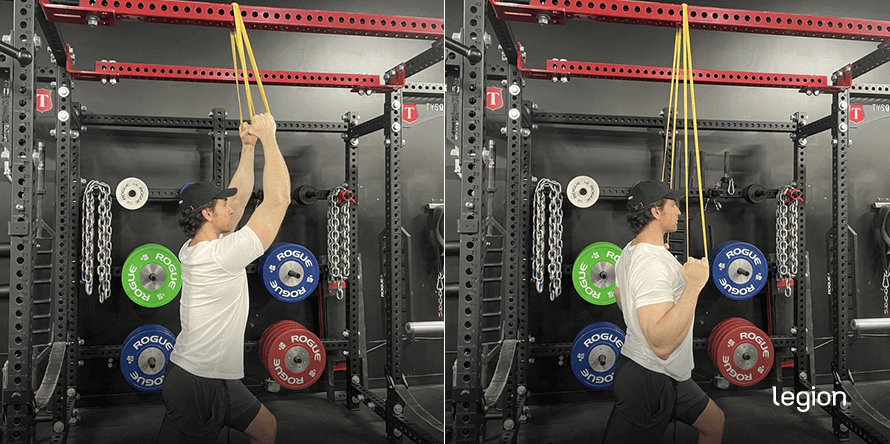
Wrap a resistance band around a pull-up bar, attic rafter, or some other point several feet above your head. Hold one end of the band in each hand and walk backward, allowing your arms to straighten, until all of the slack is out of the band.
Pull both ends of the band straight down until your hands are below your chin. Reverse the movement and return to the starting position.
Resistance Band Shoulder Exercises
1. Banded Overhead Press
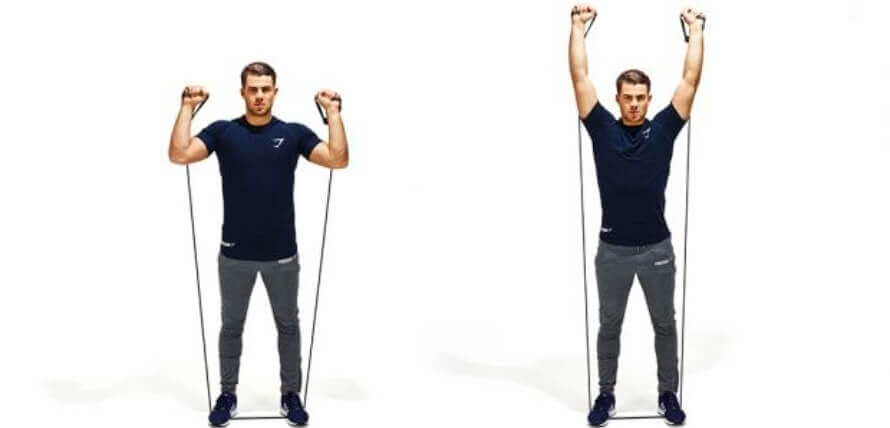
Stand on the middle of a resistance band while holding one end of it in each hand. You can stand on the band with both feet next to each other, or stagger your stance and stand on it using only one foot.
Lift your hands to your shoulders with your palms facing away from you, then press the band straight up over your head. Lower your hands to your shoulders and return to the starting position.
2. Banded Lateral Raise
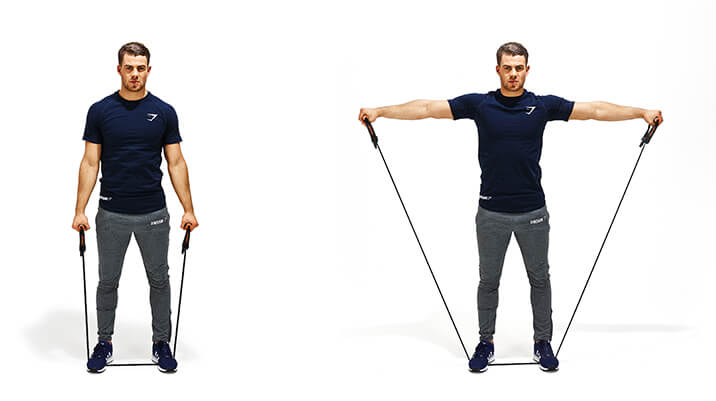
Stand on the middle of a resistance band while holding one end of it in each hand. You can stand on the band with both feet next to each other, or stagger your stance and stand on it using only one foot.
Raise your arms out to the sides until your upper arms are parallel with the floor, then reverse the movement and return to the starting position.
3. Banded Face Pull
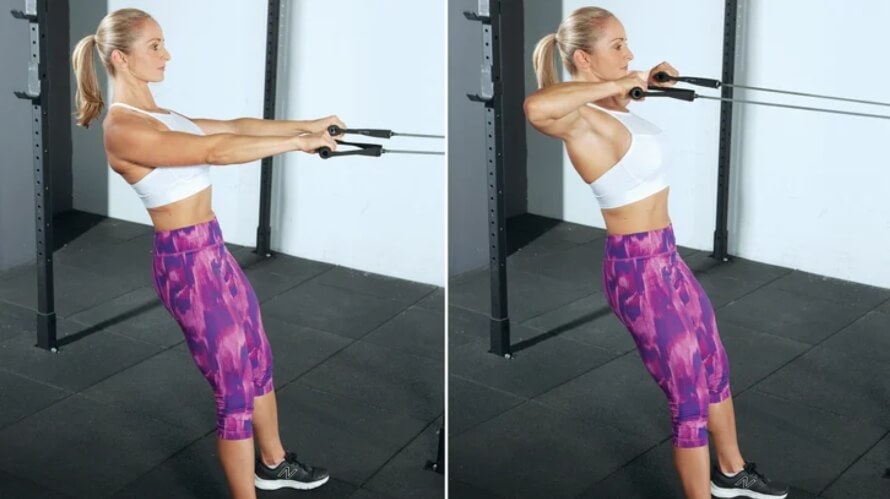
Wrap a resistance band around a sturdy post, piece of furniture, or tree at about shoulder height. Hold one end of the band in each hand and walk backward, allowing your arms to straighten, until all of the slack is out of the band. Stand up straight with a slight bend in your knees and place your feet shoulder-width apart.
While keeping your elbows up, pull the band toward your eyes allowing your hands to move apart until they’re above your shoulders, then reverse the movement and return to the starting position.
Resistance Band Leg Exercises
1. Banded Squat
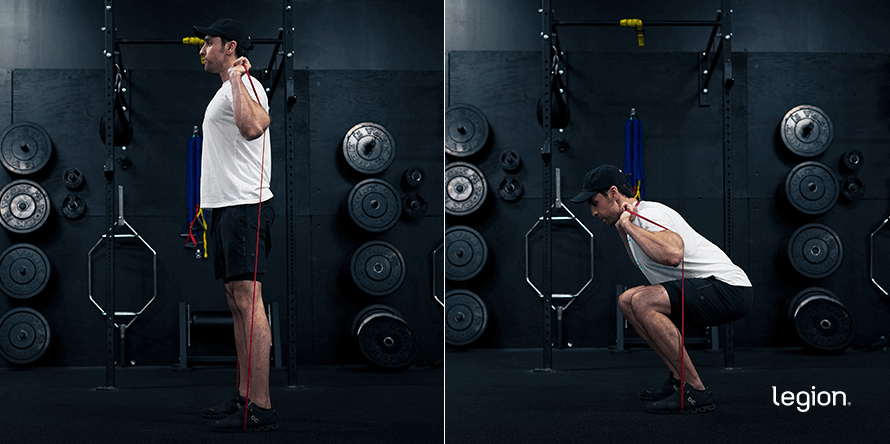
Stand on an exercise band so that it’s under the middle of both feet. Place your feet a little wider than shoulder width apart and point your toes slightly outward. Bend over, grab the loose end of the exercise band, and pull it over your shoulders (you may need to bend over if it’s a strong resistance band), holding it in place with your hands.
Once you’re standing up with the resistance band pulling on your shoulders, straighten your back and sit down. Remember to keep your back straight and push your knees out in the same direction as your toes throughout each rep.
2. Banded Single-Leg Squat
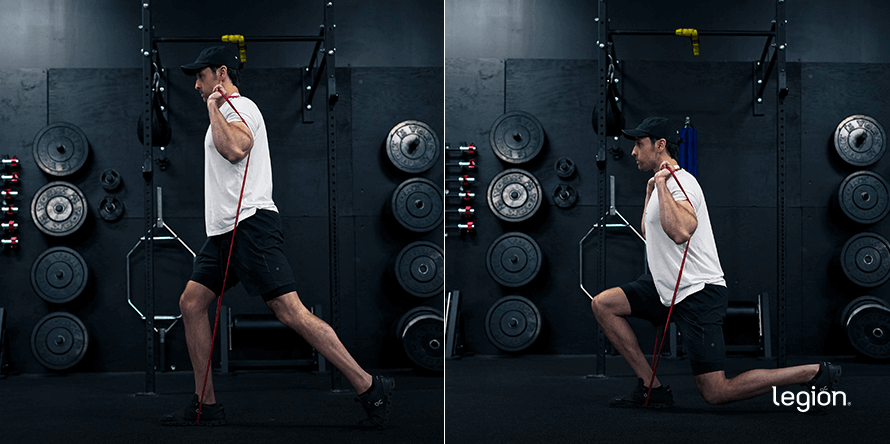
Place your right foot on an exercise band so that it lies under the middle of your foot. Bend over, grab the loose end of the exercise band, and pull it over your shoulders (you may need to bend over if it’s a strong resistance band), holding it in place with your hands.
Take a big step back with your left foot so that the ball of your foot is resting on the ground. Lower yourself until your right thigh is roughly parallel with the floor. Then, stand up and return to the starting position
3. Banded Single-Leg Romanian Deadlift
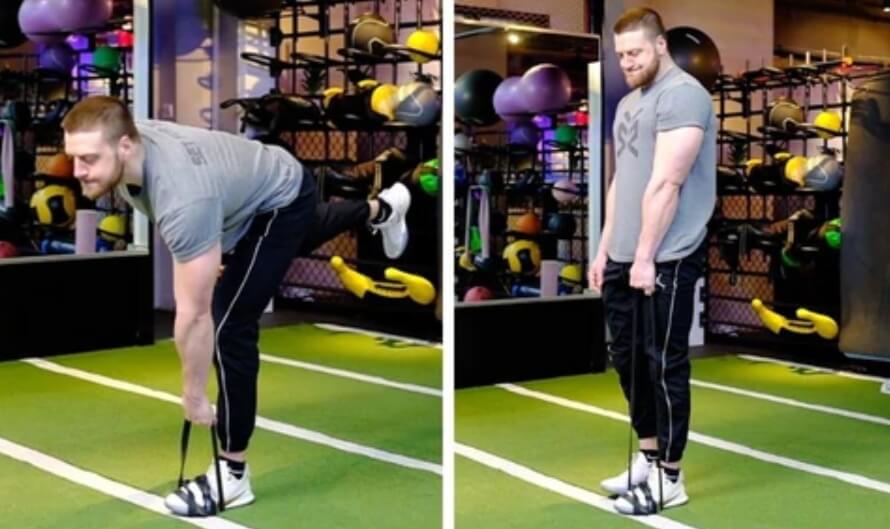
Place your left foot on an exercise band so that it lies under the middle of your foot. Bend over and grab the loose end of the exercise band in your left hand.
Keeping a slight bend in your left knee, lean forward, extending your right leg behind you and bringing your chest closer to the ground. Once you start to feel a stretch in your hamstrings and your back is almost parallel with the floor, contract your glutes and return to the starting position.
Resistance Band Arm Exercises
1. Banded Biceps Curl

Stand on the middle of a resistance band with your feet about six inches apart. Bend down and grab one end of the band in each hand. There should be no slack in the band with your arms at your sides.
Brace your core and bring both of your hands up to your shoulders by bending at the elbows. As you lift your hands, turn your wrist so that at the top of the rep, your palms are facing your shoulders. Reverse the motion to return to the starting position.
2. Banded Triceps Pushdown
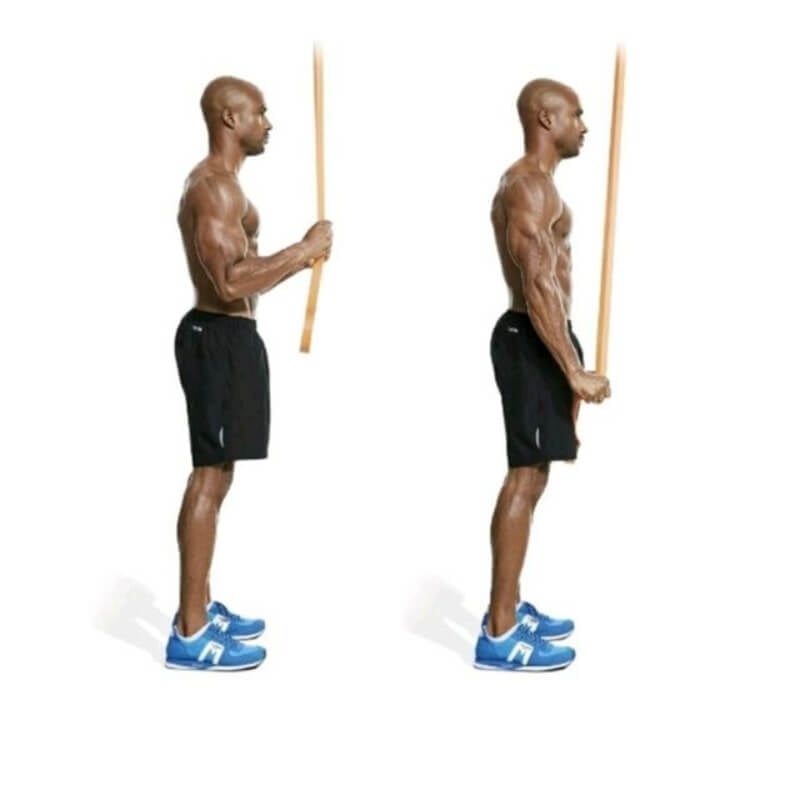
Wrap a resistance band around a pull-up bar, attic rafter, or some other point several feet above your head. Stand upright or lean slightly forward, grab one end of the band in each hand, and push the band downward by straightening your elbows. Once your arms are straight and at your sides, reverse the motion to return to the starting position.
The Best Resistance Band Workouts
The following are two of the best resistance band workout plans for building muscle. There’s a three-day total-body resistance band workout routine for beginners, and a four-day upper/lower routine for people who are intermediate or advanced.
The Best Full-Body Resistance Band Workout Plan for Beginners
In this beginner resistance band workout program, you do three workouts per week and alternate between Workout A and Workout B every time you train.
For example, one week your training schedule would look like this:
Monday: Workout A
Tuesday: Rest
Wednesday: Workout B
Thursday: Rest
Friday: Workout A
Saturday: Rest
Sunday: Rest
And the following week, your workout schedule would look like this:
Monday: Workout B
Tuesday: Rest
Wednesday: Workout A
Thursday: Rest
Friday: Workout B
Saturday: Rest
Sunday: Rest
Full-Body Resistance Band Workout A
- Banded Squat: 3 sets of 10-to-20 reps with 2-to-3 min rest
- Banded Push-up: 3 sets of 10-to-20 reps with 2-to-3 min rest
- Banded Row: 3 sets of 10-to-20 reps with 2-to-3 min rest
- Banded Triceps Pushdown: 3 sets of 10-to-20 reps with 2-to-3 min rest
Full-Body Resistance Band Workout B
- Banded Deadlift: 3 sets of 10-to-20 reps with 2-to-3 min rest
- Banded Lat Pulldown: 3 sets of 10-to-20 reps with 2-to-3 min rest
- Banded Overhead Press: 3 sets of 10-to-20 reps with 2-to-3 min rest
- Banded Biceps Curl: 3 sets of 10-to-20 reps with 2-to-3 min rest
The Best Upper/Lower Resistance Band Workout Plan for Intermediate and Advanced Weightlifters
In this upper/lower resistance band workout program, you do four workouts per week: Two upper body workouts and two lower body workouts. For your upper-body workouts you’ll alternate between Upper-Body Resistance Band Workout A and Upper-Body Resistance Band Workout B, and you’ll use the Lower-Body Resistance Band Workout for every lower-body workout.
Here’s the best way to schedule your workouts each week:
Monday: Upper-Body Resistance Band Workout A
Tuesday: Lower-Body Resistance Band Workout
Wednesday: Rest
Thursday: Upper-Body Resistance Band Workout B
Friday: Lower-Body Resistance Band Workout
Saturday: Rest
Sunday: Rest
Upper-Body Resistance Band Workout A
- Banded Push-up: 3 sets of 10-to-20 reps with 2-to-3 min rest
- Banded Lat Pulldown: 3 sets of 10-to-20 reps with 2-to-3 min rest
- Banded Overhead Press: 3 sets of 10-to-20 reps with 2-to-3 min rest
- Banded Face Pull: 3 sets of 10-to-20 reps with 2-to-3 min rest
- Banded Bicep Curl: 3 sets of 10-to-20 reps with 2-to-3 min rest
Upper-Body Resistance Band Workout B
- Banded Row: 3 sets of 10-to-20 reps with 2-to-3 min rest
- Banded Feet-Elevated Push-up: 3 sets of 10-to-20 reps with 2-to-3 min rest
- Banded Lat Pulldown: 3 sets of 10-to-20 reps with 2-to-3 min rest
- Banded Lateral Raise: 3 sets of 10-to-20 reps with 2-to-3 min rest
- Banded Triceps Pushdown: 3 sets of 10-to-20 reps with 2-to-3 min rest
Lower-Body Resistance Band Workout
- Banded Squat: 3 sets of 10-to-20 reps with 2-to-3 min rest
- Banded Deadlift: 3 sets of 10-to-20 reps with 2-to-3 min rest
- Banded Single-Leg Squat: 3 sets of 10-to-20 reps with 2-to-3 min rest
- Banded Single-Leg Romanian Deadlift: 3 sets of 10-to-20 reps with 2-to-3 min rest
FAQ #1: What’s the best resistance band workout for women?
Men and women are physiologically very similar, so women can use any of the resistance band workouts in this article.
That said, women tend to have slightly different goals than men. For example, most women want to develop their legs, abs, and butt, while men prefer to train their chest, shoulders, and arms.
If you want an exercise program and diet plan that’s specifically designed to help women gain muscle in all the right areas and lose fat like clockwork, then check out my best-selling fitness book for women, Thinner Leaner Stronger.
FAQ #2: What’s the best chest resistance band workout?
The best chest resistance band workout is:
- Banded Feet-Elevated Push-up: 4 sets of 10-to-20 reps with 2-to-3 min rest
- Banded Push-up: 4 sets of 10-to-20 reps with 2-to-3 min rest
- Banded Chest Press: 4 sets of 10-to-20 reps with 2-to-3 min rest
(And if you want to change it to a chest and tricep resistance band workout, add 3 sets of 10-to-20 reps of banded triceps pushdowns to the end of the workout above.)
FAQ #3: Do I need to take supplements if I follow a resistance band workout routine?
You don’t need to take any supplements to gain muscle and strength on a resistance band workout routine, but the right ones can help. (And if you’d like specific advice about exactly what supplements to take to reach your fitness goals, take the Legion Supplement Finder Quiz).
Here are the best supplements for supporting your resistance band workouts:
- 0.8-to-1.2 grams of protein per pound of body weight per day. This provides your body with the “building blocks” it needs to build and repair muscle tissue and help you recover from your workouts. If you want a clean, convenient, and delicious source of protein, try Whey+ protein powder or Casein+ protein powder.
- 3-to-5 grams of creatine per day. This will boost muscle and strength gain, improve anaerobic endurance, and reduce muscle damage and soreness from your workouts. If you want a 100% natural source of creatine that also includes two other ingredients that will help boost muscle growth and improve recovery, try Recharge.
- One serving of Pulse per day. Pulse is a 100% natural pre-workout drink that enhances energy, mood, and focus; increases strength and endurance; and reduces fatigue. You can also get Pulse with caffeine or without.
Scientific References +
- Bergquist, R., Iversen, V. M., Mork, P. J., & Fimland, M. S. (2018). Muscle Activity in Upper-Body Single-Joint Resistance Exercises with Elastic Resistance Bands vs. Free Weights. Journal of Human Kinetics, 61(1), 5–13. https://doi.org/10.1515/HUKIN-2017-0137
- Iversen, V. M., Mork, P. J., Vasseljen, O., Bergquist, R., & Fimland, M. S. (2017). Multiple-joint exercises using elastic resistance bands vs. conventional resistance-training equipment: A cross-over study. European Journal of Sport Science, 17(8), 973–982. https://doi.org/10.1080/17461391.2017.1337229/SUPPL_FILE/TEJS_A_1337229_SM5949.ZIP
- Aboodarda, S. J., Page, P. A., & Behm, D. G. (2016). Muscle activation comparisons between elastic and isoinertial resistance: A meta-analysis. Clinical Biomechanics (Bristol, Avon), 39, 52–61. https://doi.org/10.1016/J.CLINBIOMECH.2016.09.008
- Aboodarda, S. J., Hamid, M. S. A., Che Muhamed, A. M., Ibrahim, F., & Thompson, M. (2013). Resultant muscle torque and electromyographic activity during high intensity elastic resistance and free weight exercises. Https://Doi.Org/10.1080/17461391.2011.586438, 13(2), 155–163. https://doi.org/10.1080/17461391.2011.586438
- Vigotsky, A. D., Beardsley, C., Contreras, B., Steele, J., Ogborn, D., & Phillips, S. M. (2017). Greater electromyographic responses do not imply greater motor unit recruitment and “hypertrophic potential” cannot be inferred. Journal of Strength and Conditioning Research, 31(1), E1–E2. https://doi.org/10.1519/JSC.0000000000001249
- Kikuchi, N., & Nakazato, K. (2017). Low-load bench press and push-up induce similar muscle hypertrophy and strength gain. Journal of Exercise Science and Fitness, 15(1), 37–42. https://doi.org/10.1016/J.JESF.2017.06.003
- Calatayud, J., Borreani, S., Colado, J. C., Martin, F., Tella, V., & Andersen, L. L. (2015). Bench press and push-up at comparable levels of muscle activity results in similar strength gains. Journal of Strength and Conditioning Research, 29(1), 246–253. https://doi.org/10.1519/JSC.0000000000000589
- Lopes, J. S. S., Machado, A. F., Micheletti, J. K., de Almeida, A. C., Cavina, A. P., & Pastre, C. M. (2019). Effects of training with elastic resistance versus conventional resistance on muscular strength: A systematic review and meta-analysis. SAGE Open Medicine, 7, 2050312119831116. https://doi.org/10.1177/2050312119831116
- Schoenfeld, B. J., & Grgic, J. (2020). Effects of range of motion on muscle development during resistance training interventions: A systematic review. SAGE Open Medicine, 8, 205031212090155. https://doi.org/10.1177/2050312120901559
- Oranchuk, D. J., Storey, A. G., Nelson, A. R., & Cronin, J. B. (2019). Isometric training and long-term adaptations: Effects of muscle length, intensity, and intent: A systematic review. Scandinavian Journal of Medicine & Science in Sports, 29(4), 484–503. https://doi.org/10.1111/SMS.13375
- Rindom, E., Kristensen, A. M., Overgaard, K., Vissing, K., & de Paoli, F. V. (2020). Estimation of p70S6K Thr389 and 4E-BP1 Thr37/46 phosphorylation support dependency of tension per se in a dose-response relationship for downstream mTORC1 signalling. Acta Physiologica, 229(1), e13426. https://doi.org/10.1111/APHA.13426
- Stokes, T., Hector, A. J., Morton, R. W., McGlory, C., & Phillips, S. M. (2018). Recent Perspectives Regarding the Role of Dietary Protein for the Promotion of Muscle Hypertrophy with Resistance Exercise Training. Nutrients, 10(2). https://doi.org/10.3390/NU10020180
- Branch, J. D. (2003). Effect of creatine supplementation on body composition and performance: a meta-analysis. International Journal of Sport Nutrition and Exercise Metabolism, 13(2), 198–226. https://doi.org/10.1123/IJSNEM.13.2.198
- Eckerson, J. M., Stout, J. R., Moore, G. A., Stone, N. J., Iwan, K. A., Gebauer, A. N., & Ginsberg, R. (2005). Effect of creatine phosphate supplementation on anaerobic working capacity and body weight after two and six days of loading in men and women. Journal of Strength and Conditioning Research, 19(4), 756–763. https://doi.org/10.1519/R-16924.1
- Bassit, R. A., Pinheiro, C. H. D. J., Vitzel, K. F., Sproesser, A. J., Silveira, L. R., & Curi, R. (2010). Effect of short-term creatine supplementation on markers of skeletal muscle damage after strenuous contractile activity. European Journal of Applied Physiology, 108(5), 945–955. https://doi.org/10.1007/S00421-009-1305-1










